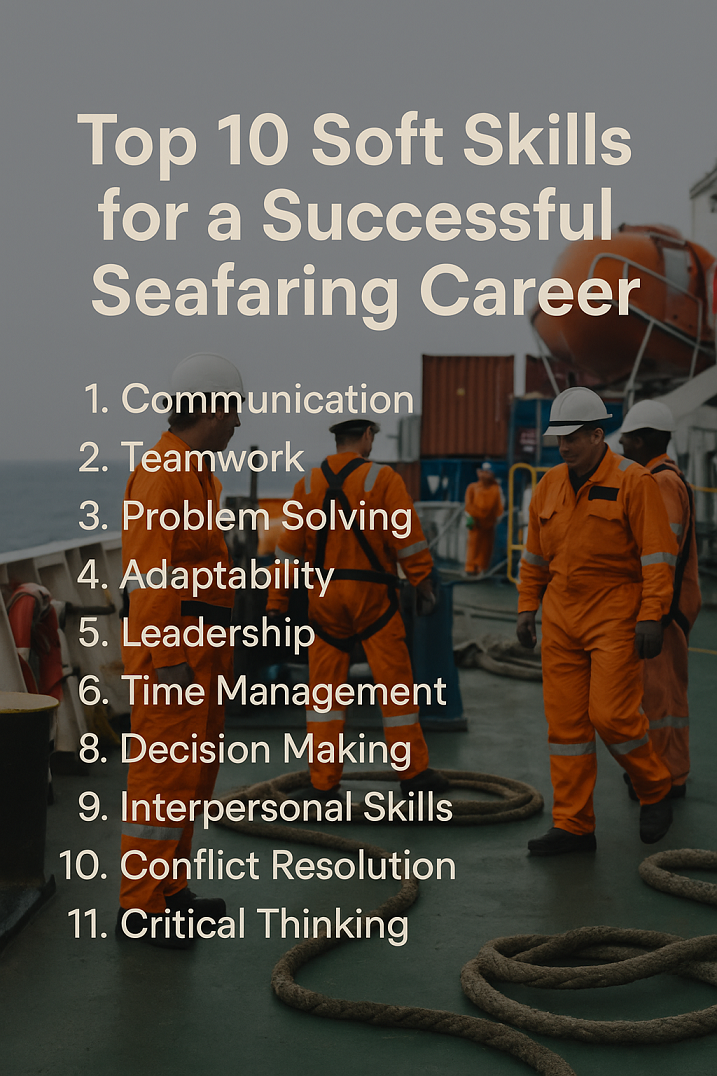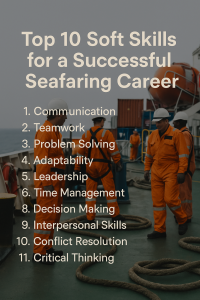Explore the top 10 soft skills every seafarer needs to succeed at sea. Discover how communication, adaptability, and emotional intelligence are reshaping modern maritime careers.
Why Soft Skills Matter in Modern Maritime Operations
The maritime industry is built on precision, discipline, and technical expertise—but increasingly, it’s soft skills that define long-term success at sea. While STCW certifications and technical training prepare officers and ratings for the operational aspects of life onboard, it’s the ability to communicate effectively, lead under pressure, and work harmoniously in multicultural crews that often determines career progression.
According to the International Chamber of Shipping (ICS) and the BIMCO/ICS Seafarer Workforce Report (2021), the future of shipping depends not only on technological adaptation but also on crew cohesion, leadership capability, and cultural competence. With automation reducing manual workloads and increasing reliance on coordination, the human factor—particularly soft skills—has never been more important.
In this guide, we highlight the top 10 soft skills every seafarer must develop to thrive in an evolving and increasingly demanding maritime landscape.
The Top 10 Soft Skills for a Successful Seafaring Career
1. Communication Skills
Clear, concise communication is essential on board—whether you’re issuing commands on the bridge, reporting engine room anomalies, or coordinating emergency procedures. Miscommunication at sea can lead to accidents, delays, or even loss of life.
Example: The Costa Concordia incident (2012) highlighted how communication breakdowns—both linguistic and procedural—contributed to the tragedy.
What to Work On: Learn standardized maritime phrases (SMCP), improve English proficiency, and practice active listening during drills and meetings.
2. Teamwork and Collaboration
A vessel’s crew is a miniature, high-functioning society. Engineers, deck officers, stewards, and ratings must work as one. Effective teamwork is critical in emergencies, mooring operations, maintenance routines, and even social dynamics.
IMO Training Connection: STCW mandates Bridge Resource Management (BRM) and Engine Room Resource Management (ERM) training to foster teamwork under high-stress scenarios.
Tip: Join simulation exercises and collaborative safety drills to build your ability to perform in crew teams.
3. Emotional Intelligence (EQ)
Emotional intelligence is the ability to recognize, manage, and respond to your own emotions—and those of others. Life at sea involves extended periods of isolation, high-stress conditions, and interpersonal tension. EQ helps mitigate conflicts and support crew well-being.
Real-World Scenario: During a 2020 COVID-19 quarantine onboard a cargo vessel in the Pacific, an emotionally intelligent chief officer kept morale high by organizing safe daily routines and mediating minor disputes.
Train It: Reflective journaling, empathy exercises, and feedback sessions with mentors can help build EQ.
4. Cultural Awareness and Sensitivity
Ships today host crews from over a dozen different countries. Misunderstandings rooted in cultural norms or body language can lead to workplace friction or worse.
Statistic: A 2022 ICS survey found that over 60% of seafarers had witnessed or experienced cross-cultural miscommunication.
Solution: Learn about the customs, taboos, and values of major seafaring nationalities. Embrace diversity training during cadetship or induction.
5. Problem-Solving Skills
Unexpected events happen at sea—from mechanical breakdowns and navigational hazards to crew conflicts. Successful seafarers can assess a situation, weigh options, and take action under pressure.
Analogy: Think of a marine engineer responding to an engine overheat mid-transit. Quick diagnosis and resourceful adaptation are often more valuable than textbook answers.
Practice: Participate in simulated emergency scenarios and log your decisions for later review.
6. Leadership and Decision-Making
Even junior officers are expected to lead workgroups, safety drills, and mooring teams. Leadership isn’t just about rank—it’s about influence, responsibility, and calm authority.
Case Study: Onboard a tanker transiting the Suez Canal, a third mate took control during a medical emergency, coordinating communications and stabilizing the patient until help arrived. His training and confidence prevented panic.
Tip: Study effective leadership models (e.g., situational leadership) and request feedback during onboard evaluations.
7. Time Management
Ships run on strict schedules. Delays in watch turnover, maintenance tasks, or reporting can create safety risks or voyage delays. Mastering time management ensures smooth operations and reduces stress.
Practical Techniques:
-
Use checklists and daily logs.
-
Prioritize high-risk tasks.
-
Avoid procrastination during off-duty periods.
8. Adaptability and Flexibility
Weather changes, port delays, crew rotations, and new technology require constant adjustment. Seafarers who remain flexible—mentally and emotionally—perform better and handle change more effectively.
Recent Relevance: The pandemic required seafarers to extend contracts unexpectedly, adapt to remote port operations, and manage fatigue under difficult conditions.
Develop This Skill: Cross-train in different shipboard duties and stay informed on industry changes (e.g., IMO e-learning).
9. Stress Management and Resilience
Seafaring is psychologically demanding. Extended isolation, homesickness, and high-stakes tasks demand mental resilience.
Tools to Build Resilience:
-
Daily exercise routines
-
Meditation or breathing techniques
-
Digital check-ins with family or mental health support platforms like ISWAN’s SeafarerHelp
Statistic: According to ISWAN, 28% of seafarers reported anxiety-related symptoms during long voyages in 2021.
10. Conflict Resolution
Disagreements are inevitable in confined quarters. The ability to de-escalate tension, negotiate outcomes, and restore teamwork is vital for crew cohesion.
IMO Emphasis: Conflict management is embedded in Leadership and Teamwork training under STCW A-III/1 and A-II/1.
Training Tip: Practice role-plays in pre-departure briefings or request mediation mentoring from senior crew.
Case Studies: Soft Skills in Action
Case Study 1: Bridging Cultures on the Bridge
On a container vessel operated by a European shipping company, a young Filipino second officer used his knowledge of both Eastern and Western workplace dynamics to resolve a conflict between a Russian chief mate and Indian deck ratings. His cultural awareness and tact restored cooperation, and the captain praised his emotional intelligence in the voyage report.
Case Study 2: Resilience Saves the Mission
During a maintenance delay in the Gulf of Aden, a chief engineer motivated his crew to complete 14-hour shifts for four consecutive days by rotating workloads, sharing feedback sessions, and organizing social activities. The mission stayed on schedule, and no crew reported mental fatigue afterward.
Frequently Asked Questions (FAQ)
Q1: Are soft skills part of the STCW training?
A: Yes. Modules like Bridge Resource Management (BRM) and Leadership & Teamwork explicitly focus on soft skills such as communication, decision-making, and conflict resolution.
Q2: Can soft skills affect career advancement?
A: Absolutely. Employers prioritize officers who show emotional intelligence, leadership, and adaptability—especially for senior roles or shore-based positions.
Q3: How can I improve my soft skills while onboard?
A: Request feedback, join training drills, engage in multicultural conversations, and reflect on interactions through journaling or debriefing.
Q4: Are there online courses for maritime soft skills?
A: Yes. Platforms like IMO e-learning, Seably, and ISWAN offer soft skills modules.
Q5: Why are soft skills more important today than in the past?
A: Automation has reduced repetitive manual labor, shifting emphasis to human coordination, leadership, and crisis management—areas where soft skills dominate.
Q6: How do cultural differences affect teamwork on ships?
A: Differing norms in communication, hierarchy, and conflict resolution can create tension if not managed well. Cultural sensitivity fosters better team cohesion.
Conclusion
In the maritime world, competence isn’t just measured in engine parameters or navigational accuracy—it’s seen in how you lead a team, manage a crisis, and communicate across cultures. Soft skills are your compass in uncertain waters, your anchor in difficult times, and your sail in calm seas.
Whether you’re starting your first contract or eyeing the Chief Officer’s chair, investing in these soft skills will shape not just your career—but the safety and success of every voyage you undertake.
🌊 Discover more career resources, certification guides, and mentorship opportunities at MaritimEducation.com.
References
-
BIMCO/ICS. (2021). Seafarer Workforce Report. https://www.ics-shipping.org
-
International Maritime Organization. (2023). STCW Convention and Leadership Training Modules. https://www.imo.org
-
International Seafarers’ Welfare and Assistance Network (ISWAN). (2022). Mental Health and Seafarer Wellbeing. https://www.seafarerswelfare.org
-
ICS. (2022). Maritime Human Element and Safety Culture Survey. https://www.ics-shipping.org


